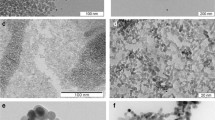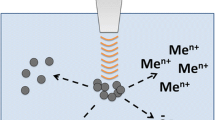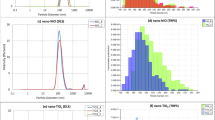Abstract
Toxicological testing of nanomaterials often involves in vitro studies of nanoscale powders, which, therefore, need to be dispersed. Various dispersion approaches have been described in the literature, with the main differences between them being the sonication method, the medium, and the additives used. In the present study, five dispersion approaches were compared using titanium dioxide nanoparticles (Aeroxide TiO2 P25). Three of the selected approaches were two- or multi-step processes consisting of dispersion in water followed by transfer to cell culture media, while the two other procedures include only the dispersion in water or in media. One approach was based on bath sonication, whereas the others used direct sonication through insertion of a probe into the sample. The main finding arising out of the comparison of the direct dispersion methods was that the specific energy input played a crucial role in determining the achievable particle size (133–182 nm). A low volume of liquid and a relatively low power in conjunction with a long pulsed dispersion time were found to be favorable for minimizing the side effects of ultrasonication like radical formation or material degradation. The resulting size in the cell culture media showed a strong dependence on the dilution method. Predilution with water before addition to the media prevented the agglomeration of the TiO2 particles under physiological conditions. Direct dispersion in media resulted in the smallest dispersible size. This study succeeded in furthering the understanding of the dispersion process and yielded useful tips for avoiding pitfalls in the preparation of suspensions for toxicological experiments.




Similar content being viewed by others
References
Arora S, Rajwade JM, Paknikar KM (2012) Nanotoxicology and in vitro studies: the need of the hour. Toxicol Appl Pharm 258:151–165
Bihari P, Vippola M, Schultes S, Praetner M, Khandoga AG, Reichel CA, Coester C, Tuomi T, Rehberg M, Krombach F (2008) Optimized dispersion of nanoparticles for biological in vitro and in vivo studies. Part Fibre Toxicol 5:14
Cedervall T, Lynch I, Lindman S, Berggard T, Eva Thulin, Nilsson H, Dawson KA, Linse S (2007) From the cover: understanding the nanoparticle-protein corona using methods to quantify exchange rates and affinities of proteins for nanoparticles. PNAS 104:2050–2055
Chithrani BD, Ghazani AA, Chan WCW (2006) Determining the size and shape dependence of gold nanoparticle uptake into mammalian cells. Nano Lett 6:662–668
Cohen J, DeLoid G, Pyrgiotakis G, Demokritou P (2012) Interactions of engineered nanomaterials in physiological media and implications for in vitro dosimetry. Nanotoxicology 7:417–431
Dhawan A, Sharma V, Parmar D (2009) Nanomaterials: a challenge for toxicologists. Nanotoxicology 3:1–9
Gil PR, Oberdörster G, Elder A, Puntes V, Parak WJ (2010) Correlating physico-chemical with toxicological properties of nanoparticles: the present and the future. ACS Nano 4:5527–5531
Hackley VA, Stefaniak AB (2013) “Real-world” precision, bias, and between-laboratory variation for surface area measurement of a titanium dioxide nanomaterial in powder form. J Nanopart Res 15:1742
Handy R (2012) Guidance from EU FP7 project MARINA. TiO2 nanoparticle stock preparation. Final version, 12 July 2012
ISO 22412 (2008) Particle size analysis—dynamic light scattering (DLS). International Organisation for Standardization, Geneva
Jiang J, Oberdörster G, Biswas P (2009) Characterization of size, surface charge, and agglomeration state of nanoparticle dispersions for toxicological studies. J Nanopart Res 11:77–89
Lynch I, Dawson KA (2008) Protein-nanoparticle interactions. Nano Today 3:40–47
Magdolenova Z, Bilaničová D, Pojana G, Fjellsbø LM, Hudecova A, Hasplova K, Marcomini A, Dusinska M (2012) Impact of agglomeration and different dispersions of titanium dioxide nanoparticles on the human related in vitro cytotoxicity and genotoxicity. J Environ Monit 14:455–464
Maier M, Hannebauer B, Holldorff H, Albers P (2006) Does lung surfactant promote disaggregation of nanostructured titanium dioxide? J Occup Environ Med 48:1314–1320
Mandzy N, Grulke E, Druffel T (2005) Breakage of TiO2 agglomerates in electrostatically stabilized aqueous dispersions. Powder Technol 160:121–126
Meißner T (2012) Methoden der Nanopartikelcharakterisierung zur Optimierung toxikologischer Studien. Dissertation. Technical University Dresden, Dresden
Meißner T, Potthoff A, Richter V (2009) Physico-chemical characterization in the light of toxicological effects. Inhal Toxicol 21:35–39
Meißner T, Kühnel D, Busch W, Oswald S, Richter V, Michaelis A, Schirmer K, Potthoff A (2010) Physical-chemical characterization of tungsten carbide nanoparticles as a basis for toxicological investigations. Nanotoxicology 4:196–206
Müller RH (1996) Teilchengrößenmessung in der Laborpraxis. APV paperback series, vol 38. Wissenschaftliche Verlagsgesellschaft, Stuttgart
Naddeo V, Belgiorno V, Napoli RMA (2007) Behaviour of natural organic mater during ultrasonic irradiation. Desalination 210:175–182
Nanommune (2011) Quality handbook—standard procedures for nanoparticle testing. http://www.nanosafetycluster.eu/uploads/QUALITY_HANDBOOK/NANOMMUNE_QHB_FINAL_2011.pdf. Accessed 29 May 2012
Nel A, Xia T, Mädler L, Li N (2006) Toxic potential of materials at the nanolevel. Science 311:622–627
NIST SRM1898 (2012) Certificate of analysis. Standard Reference Material® 1898 titanium dioxide nanomaterial. National Institute of Standard and Technology, Gaithersburg
Oberdörster G, Maynard A, Donaldson K, Castranova V, Fitzpatrick J, Ausman K, Warheit D, Yang H (2005) Principles for characterizing the potential human health effects from exposure to nanomaterials: elements of a screening strategy. Part Fibre Toxicol 2:8
Passagne I, Morille M, Rousset M, Pujalté I, L’Azou B (2012) Implication of oxidative stress in size-dependent toxicity of silica nanoparticles in kidney cells. Toxicology 299:112–124
Pohl M, Hogekamp S, Hoffmann NQ, Schuchmann HP (2004) Dispergieren und Desagglomerieren von Nanopartikeln mit Ultraschall. Chem Ing Tech 76:392–396
Saber AT, Jensen KA, Jacobsen NR, Birkedal R, Mikkelsen L, Møller P, Loft S, Wallin H, Vogel U (2012) Inflammatory and genotoxic effects of nanoparticles designed for inclusion in paints and lacquers. Nanotoxicology 6:453–471
Stebounova L, Guio E, Grassian V (2011) Silver nanoparticles in simulated biological media: a study of aggregation, sedimentation, and dissolution. J Nanopart Res 13:233–244
Taurozzi JS, Hackely VA, Wiesner MR (2011) Ultrasonic dispersion of nanoparticles for environmental, health and safety assessment—issues and recommendations. Nanotoxicology 5:711–729
Taurozzi JS, Hackely VA, Wiesner MR (2012) A standardised approach for the dispersion of titanium dioxide nanoparticles in biological media. Nanotoxicology 7:389–401
Wang J, Wu J, Zhang Z, Zhang X, Pan Z, Wang L, Xu L (2006) Sonocatalytic damage of bovine serum albumin (BSA) in the presence of nanometer anatase titanium dioxide (TiO2). Ultrasound Med Biol 32:147–153
Wick P, Manser P, Limbach LK, Dettlaff-Weglikowska U, Krumeich F, Roth S, Stark WJ, Bruinink A (2007) The degree and kind of agglomeration affect carbon nanotube cytotoxicity. Toxicol Lett 168:121–131
Zook JM, Maccuspie RI, Locascio LE, Halter MD, Elliott JT (2011) Stable nanoparticle aggregates/agglomerates of different sizes and the effect of their size on hemolytic cytotoxicity. Nanotoxicology 5:517–530
Acknowledgments
The research leading to these results has received funding from the European Union Seventh Framework Programme (FP7/2007-2013) under Grant Agreement No. 263147 (NanoValid—Development of reference methods for hazard identification, risk assessment and LCA of engineered nanomaterials).
Author information
Authors and Affiliations
Corresponding author
Electronic supplementary material
Below is the link to the electronic supplementary material.
Rights and permissions
About this article
Cite this article
Meißner, T., Oelschlägel, K. & Potthoff, A. Dispersion of nanomaterials used in toxicological studies: a comparison of sonication approaches demonstrated on TiO2 P25. J Nanopart Res 16, 2228 (2014). https://doi.org/10.1007/s11051-013-2228-7
Received:
Accepted:
Published:
DOI: https://doi.org/10.1007/s11051-013-2228-7




